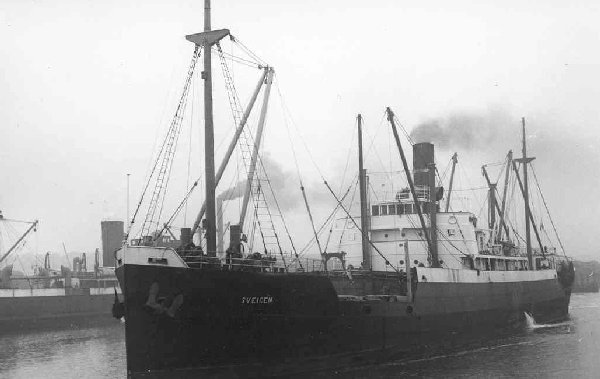Janna
Norwegian Steam merchant

Janna under her former name Sveigen. Photo from sjohistorie.no
| Name | Janna | ||
| Type: | Steam merchant | ||
| Tonnage | 2,197 tons | ||
| Completed | 1919 - Albina Engine & Machine Works Inc, Portland OR | ||
| Owner | Pehrson & Wessel, Drammen | ||
| Homeport | Drammen | ||
| Date of attack | 11 Jul 1940 | Nationality: | |
| Fate | Sunk by U-34 (Wilhelm Rollmann) | ||
| Position | 50° 34'N, 12° 10'W - Grid BE 3328 | ||
| Complement | 25 (0 dead and 25 survivors). | ||
| Convoy | HX-54 (straggler) | ||
| Route | St. John’s, Newfoundland (18 Jun) - Halifax (29 Jun) – Falmouth | ||
| Cargo | 819 fathoms of pulp wood | ||
| History | Completed in March 1919 as Glendola for US Shipping Board (USSB). 1920 sold to Glendola SS Corp (Atlantic Fruit Co Inc), New York. 1930 sold to Norway and renamed Sveigen for Rederi-A/S Henneseid (Thoralf Holta), Porsgrunn. 1936 renamed Janna for J.H. Wessels Kulforretning A/S (Pehrson & Wessel), Drammen. | ||
| Notes on event | At 07.06 hours on 11 July 1940 the unescorted and unarmed Janna (Master Thorbjørn Aleksander Bøttger) was hit on the port side underneath the bridge by one G7e torpedo from U-34 while steaming on a non-evasive course at 8.5 knots about 115 miles west-southwest of Cape Clear. The ship had originally left Halifax in convoy HX-53, but lost touch and returned to port on 27 June and departed again two days later to join convoy HX-54 at sea, however failed to join it in very thick fog and proceeded independently. The explosion blew a part of the bridge away and the ship settled quickly by the bow with a list to port until sinking vertically at about 08.00 hours. All crew members safely abandoned ship in three lifeboats despite a gale sea and a fresh breeze blowing at the time. The U-boat did not surface and left the area because shortly after the attack a Sunderland aircraft approached and circled the sinking ship, but the Germans later spotted two lifeboats from this ship when passing the area again during the afternoon. No distress signal had been sent as the survivors hoped that the aircraft would report them and they waited a while before setting course for Ireland after all men transferred into two boats and collecting supplies and equipment from the abandoned boats and rafts, initially using the motor boat to tow the other boat until setting sail to save petrol. They had plenty of food and water, but were unable to sleep due to the very rough weather. Unknown to them, the aircraft had reported their position to the nearby convoy HX-54 which detached the British tug Sabine to search for survivors. However, the tug only found large quantities of drifting wood in the area and rejoined convoy after six hours. On the afternoon of 12 July, the Estonian steam merchant Kai passed close to the lifeboats and was hailed by the survivors who asked to be picked up. The ship stopped her engines, but for unknown reasons suddenly proceeded and left the occupied lifeboats behind while they rounded her stern to get to the lee side in the very bad weather. At 21.00 hours on 13 July, the survivors were picked up by the British decoy ship HMS Beauly (X 63) (Cdr F.H. Ashton, RN), disguised as Looe, after attracting her by firing three or four red rockets about five miles from Mizen Head, Ireland. All survivors were in an exhausted condition and four of them required medical attention. They were accommodated forward in order not to disclose the true identity of the vessel. An attempt was made to tow the lifeboats in by the vessel, but the towing was abandoned during the night owing to bad weather. The survivors were landed at Milford Haven late in the evening of 14 July. | ||
| More info | |||
| On board | We have details of 20 people who were on board. | ||
If you can help us with any additional information on this vessel then please contact us.
